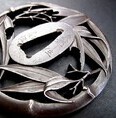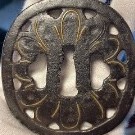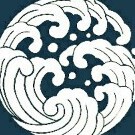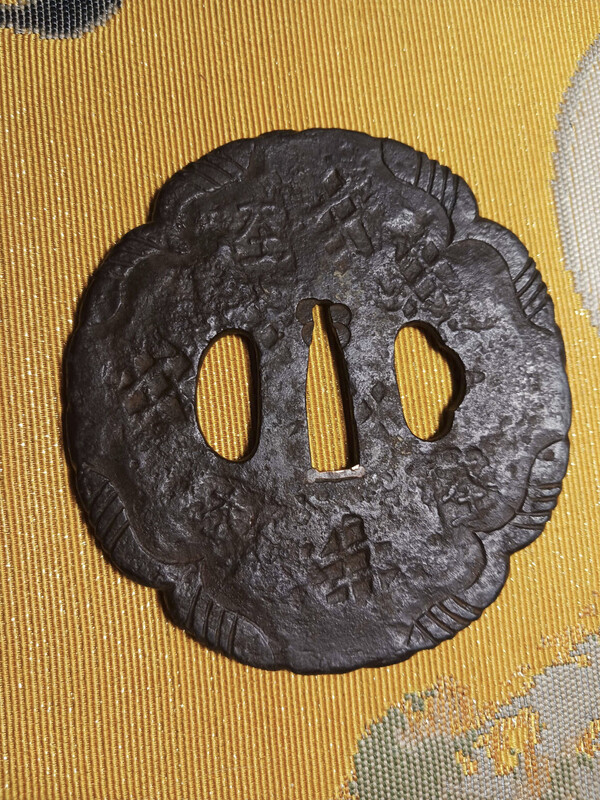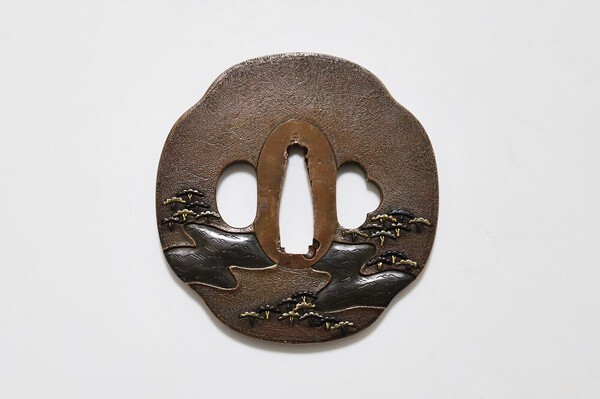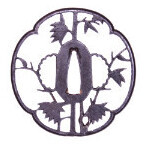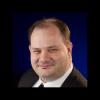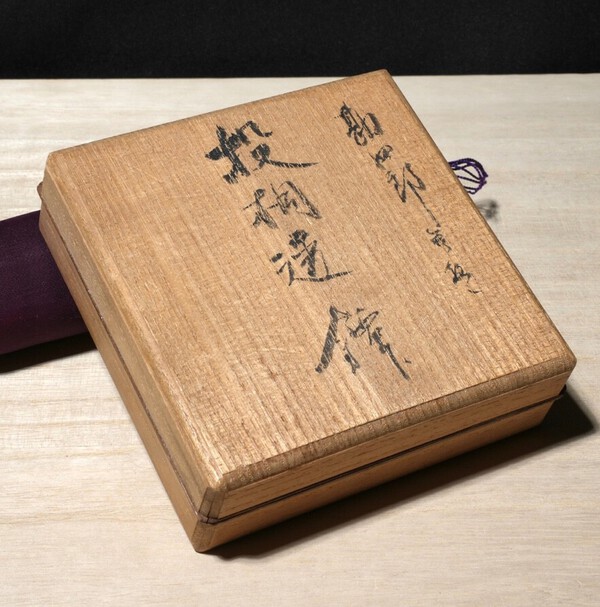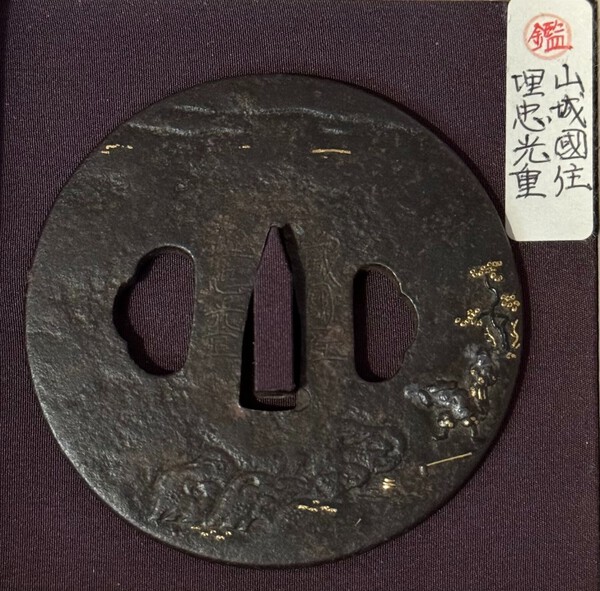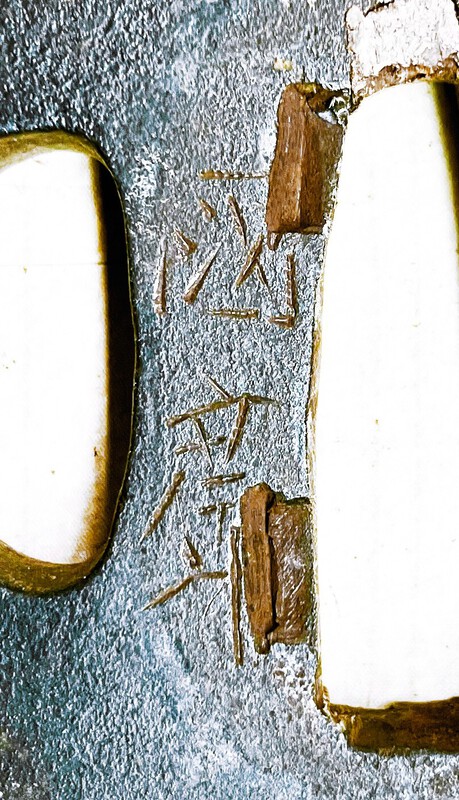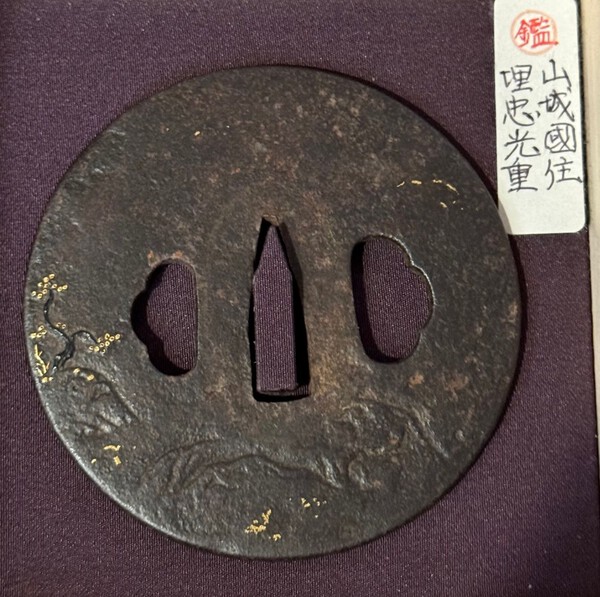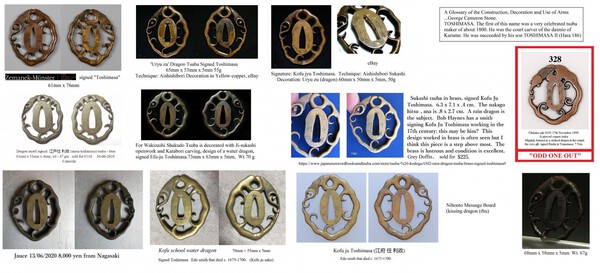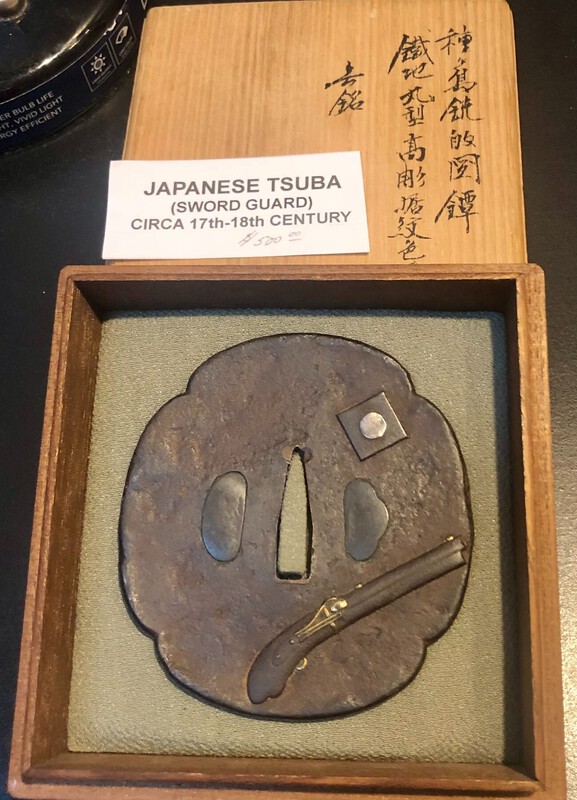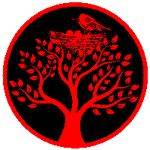Search the Community
Showing results for tags 'tsuba'.
-
There is a nice openwork tsuba book on Jauce that the seller won't ship internationally. Any members of the community who lives in Japan or knows of someone in Japan who would be so kind as to assist with shipping it to me in Florida after Jauce ships it locally within Japan? Fully at my cost of course. Thanks in advance. Steve
-
Hello! Tsuba - bamboo tree. 1000 euros. Material is iron Mei/signature: 東都住貞恒 Toto Ju Sadatsune, Period/era: Edo, Certificate: None, Measures: 7.8 cm x 7.3 cm x 0.40 cm. Location: Germany, Berlin. Payment via PayPal or in person in Berlin. Alexander
-
Dear members, I am offering here a tsuba that is rarely seen in this combination. Mount Fuji with pine trees at the base ( not identical on both sides, but with variations) and the material is suaka, with plenty of leftover urushi. Beautiful color. Photos are made in the morning sun. Kokinko tsuba, suaka, Momoyama/ early Edo 66mm x 66mm. Relatively thick at 5.5mm, 123 gr. Price: 1800 € (excl. package and posting)
-
I bought this tsuba for 25$ on catawiki from Japan. Is this tsuba legit? What time period is it from? What school? https://drive.google...Jru_g1Xr?usp=sharing Photos are in the drive folder the file were to big to upload. I would be very happy if someone could help me.
-
My father in law took me to an antique/gomi store here in Fukuoka. Some really great stuff, no pictures allowed though. I saw this tsuba for 3,000 yen and decided to buy it. The owner is a little old lady, sweet and a true salesman. David
-
Hello all! I recently came into possession of an iron tsuba. Based off what I've seen it's a Tempo tsuba and (probably) latter Edo Period. Any information would be greatly appreciated!
-
Hi, I am new here, and I would like to show/ask for opinion on the dawn of my collection. Those are my first aquisitions, I dont know much about them and would like to learn more from people who are capable of telling more than eye can see. And to add some information, all of them have Hozon token from NBTHK Tsuba no.1 Tsuba no.2 Tsuba no.3 Tsuba no.4 Thank you for any comments about my new pieces.
-
Dear collectors and readers interested in Tsuba, I am parting with a significant part of my collection so please feel welcome to buy or make an offer on the items shown. Kyo-Shoami - NBHTK Hozon certificate- 1100 € Higo - probably Nishigaki - 320 € Tosa Myochin - 650 € Heianjo Sukashi - 1700 € Akao - water well - 350 € Akasaka - Chrysanthenum - NBTHK Hozon certificate - 700 € Akasaka - Sugawara Denju Tanarai Kagami - 450 € Akasaka - Pine, Karigane, Moon - NBTHK hozon certificate - 750 € Akasaka - Stick figure - 500 € Kyo Shoami - Itomaki Hanabishi - NBTHK Hozon certificate - 600 € Late Edo Owari - 150 € Kyo Shoami - Take Bamboo - 450 € To reduce traffic on the board - more pictures only on request by pm. Shipping from France or Germany at best rates - typically the next day. (example: US ships for 22,50€, Europe 14,00€, France and Germany: free) Best wishes, Tobi
-
Hello guys, I just came across this tsuba and was wondering about your opinion on the work. I am asking because I know there is a wealth of knowledge across the members and I am 'green' in this so trying to learn more about what to look for and 'how' to look (to distinguish the quiality of metal itself and metal work details, etc.). For this piece I quite like aesthetically the shell motif. I would say that it has not been mounted on the sword and the punches on the seppa dai somehow do not seem 'convincing'. It is signed as Echizen Kinai and I did read a thread on this forum (about 1 year old) about another Echizen Kinai tsuba in which the member well explained that they did a lot of 'mass' production. I would say this is a typical representation of this mass production (just a mediocre tsuba), but other than that I would be curious about other observations by people who are more experienced than me. I will be very grateful for any insights and observations you guys have! Best wishes Lukas
-
I am looking for Kanayama and Owari tsuba from the late Muromachi to early Edo period (approximately 1575-1610). I have seen some nice early sukashi guards in this category posted on NMB in the past. I am also interested in original Oribe tea cups/bowls from the Momoyama period. Thanks.
-
I just wanted to share this quick photo of a new tsuba I picked up for my birthday. I haven't had a chance to photograph it and this photo was taken by the previous owner. The iron feels very nice in hand and design motif a classic one with an interesting variation. I will take some of my own photos later. Feel free to discuss it politely.
- 15 replies
-
- 11
-

-

-
Dear all I would like to part with a nice early Tempo/Tembo/Tenpo tsuba. The kokuin stamp used to create the surface pattern has a kiri design. The quality of the iron is good and the lamination can be seen in the nagako and hitsu-ana. Finally, the tsuba has a Sukidashi-mimi. If you want to learn more about Tempo tsuba, there is a well written article about Tempo Tsuba by Malcolm E. Cox available in the Download Section. Dimensions: Tsuba: 8.09 cm x 8.16 cm x 0.3 cm Nakago-ana: 3.36 cm x 1.01 cm (widest point) Asking price: EUR 170.00 Shipping costs including tracking and insurance are: Germany EUR 6.99 EU EUR 16.49 UK EUR 26.99 Worldwide EUR 47.99 Best Chris
-
There is a listing on Jauce of a nice classic paulownia design with hakogaki that my translator app can’t decipher. Kebori is weak, but composition is exactly like a 2nd generation Kanshiro. Hard to tell if smaller hits-ana for kogai is instead a reflection of Akasaka school or just the reflection of a composition/design element. Any thoughts? https://www.jauce.com/auction/h1143443304
-
This tsuba has somehow ended up in my small and somewhat scattered collection from a distant past (25 years ago??) while I was living in Singapore and before I started collecting early sukashi tsuba at the beginning of this year. I just had David help out with the mei translation. Haynes H05405.0. Based on death before 1781 (An Ei), this tsubako appears to be a contemporary of the 7th (Shigehide) and 8th (Yoshihisa) generation of the Umetada Kyoto School. The writing on the white stickies are from the previous owner (there is another one on underside of lid). There is a carved and overlaid scene of two figures at 4:00 with landscape elements beneath clouds on omote. The tree and rocks wrap around to the ura. There are two kogai hitsu-ana of differing sizes. 74 mm (perfectly round), 4.7 mm, 4.0 at mimi. Comes in newish paulownia box. $350 (or best offer)
-
Hello together, I recently received a katana which seems to be "shuffled" together. None of the parts seem to match each other. The tsuba has a signature, but I can hardly imagine that this is Japanese at all. Does anybody have an idea what this could mean or be? Best regards Roland
-
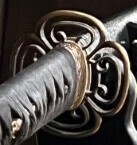
Tadamitsu Iron Plate, Translation and Identification Help Please
Iaido dude posted a topic in Tosogu
Here is an iron plate with mei showing Tadamitsu (from Yamashiro Province??). Would be wonderful if one of our members can provide the full translation. "Tadamitsu" appears on left side of seppa dai flanked by two characters. Yamashiro appears on right side. Tadamitsu seems to be variously associated with the Akasaka and Higo schools, but this is not a sukashi tsuba so it seems doubtful to me. I can't otherwise identify this specific smith from Yamashiro Province. The hand written label was added by prior owner presumably. This tsuba has somehow ended up in my small and somewhat scattered collection from a distant past (25 years ago??) while I was living in Singapore and before I started collecting sukashi tsuba at the beginning of this year. I am looking to sell this piece. There is a scene of two figures at 4:00 with landscape elements beneath clouds on omote. The tree and rocks wrap around to the ura. There are two kogai hitsu-ana of differing sizes. 74 mm (perfectly round), 4.7 mm, 4.0 at mimi. -
1) Tsuba - Akasaka School Japan, Original https://www.ebay.de/itm/176263757878 Antik. Edo. Original aus Japan. School: probably early Akasaka 3rd Gen. Age: Edo Period / Region: Tokio Dimension: Size 66,8 mm x 70,4 mm x 6,2 mm (6,2/6,6), 65,9 g 2) Tsuba - Japan, Original https://www.ebay.de/itm/176263758854 Antik. Edo. Original aus Japan. School: reminds me of Tochihata. Age: pre-Edo Period Dimension: Size 62,3 mm x 63,0 mm x 5,1 mm (5,0), 55,1 g 3) Tsuba - Karigane - wild geese, Akasaka motive Japan, Original https://www.ebay.de/itm/176263759358 The Tsuba is made in the "Sukashi" technique, potentially made with a chisel and filing during Edo Period. The motive represents Karigane (Geese) in Flight, which is a typical Akasaka Motive. The patination and color of steel is typical for these authentic historic pieces. School: probably later Akasaka Age: Edo Period / Region: Tokio Dimension: Size 66,8 mm x 70 mm x 6,0 mm (6,3), 87 g
-
The gourd (hyotan 瓢箪) is my spirit vegetable it seems. As a motif in asian arts and crafts I have grown up with them. It is fitting then that a few Momoyama Period Kanayama tsuba currently in my small collection use the double hyotan (small upper half, larger lower half) as subtly recognizable motifs. Kanayama tsuba are generally described as being symmetrical and with patterns that are abstract, which I find to be especially true for Muromachi Period pieces. Those forged during the early Edo period are also rather stiff and more Tokugawa in their confirmatory sensibility. The Momoyama sensibility is “looser,” freer, with greater vitality and exuberance that is unique to this time and as informed by the aesthetic principles of Tea Ceremony. The two Kanayama tsuba reflect this sensibility and are carved in ji-sukashi. Hyotan have been long used in Japan as containers for sake, water, and flowers; regarded as lucky charms; gourd shapes appear as architectural motifs, cartouches for woodblock prints, and signatures of print artists; multiple gourds on a battle standard (sennari hyotan) is attributed to Toyotomi Hideyoshi who unified Japan in the late 16th century1; and gourds, as it turns out, are among those motifs found on sword guards (tsuba) mounted on katana or wakizashi. From the zen point of view, the hollow gourd denotes emptiness and seeking truth first through an inward gaze at the self.2 For bushi it may have served to ward off bad luck on the battlefield where the possibility of a deadly outcome was ever present. 1Symbols of Japan, Thematic Motifs in Art and Design, Baird, Merrily, Rizzoli International Publications, Inc, 1944 2Zen Painting and Calligraphy, 17th-20th Centuries Exhibition, Woodson, Yoko, Asian Art Museum of San Francisco, Chong-Moon Lee Center for Asian Art and Culture, 2001 Tsuba 1: When I first saw this gem, I almost missed the somewhat abstract hyotan motif that is actually integral to the composition. I thought they were buddhists beads. There are two double hyotan that form the hitsu-ana on either side, anchored on what appear to be stems. There are counter weights above and below. Tsuchime is enhanced in natural sunlight. The patina is a dark brown. It has enough globular tekkotsu on the rim to fuel a rocket to the moon. It is a nearly perfectly round murugata shape. 73.5 x 72.5 x 4.6 (4.9 at mimi) mm Tsuba #2 (please see next post below)
-
Raising $ for my Kanayama/Owari Fund. This is a love daisho with plum branch and blossom theme in copper, silver, gold, shakudo inlay/overlay. $650 including shipping in US (ask for quote for international). Links to similar examples with various attribution to Ko-Nara or Umetada. https://www.worthpoi...-guard-ume-tsuba-for https://www.ngv.vic....llection/work/54298/ Katana: 73.2, 68.6, 4.5, 4.0 mimi Wakizashi: 69, 62.8, 4.0, 3.2 mimi
-
Back before the world went Covid, in 2019 Leon Kr posted a thread http://www.militaria.co.za/nmb/topic/30455-help-needed-with-mei/ That he never really got a straight answer to. I believe because at the time it was dismissed as 'oh no not another cast copy'. Well having just stumbled upon it, I thought to clarify a rather muddy topic. I am normally on the look out for mass produced copies and have posted a few threads on this subject - however this time I would like to show a collection of mass individual pieces 'utsushi' I would guess. From my research there are quiet a range of metals used in their construction but they tend to have three distinct features either a full signature. A partial signature. Or are not signed. The design is always the same but I have yet to see any, that are an exact copy of another. The signatures according to the various owners or sellers usually state to be 'Toshimasa' - Then it gets mixed up - Kofu ju Toshimasa, Kofu jyu Toshimasa, Sumu Toshimasa and the book by the members of the 'Japanese sword society of New York' 1966 describe the maker as 'Mitsunobu (Bushu {Musashi} Province) yet apart from the last, the Kanji is all the same? Toshimasa had several designs, Leon Kr's 'Waves and Birds' also becomes 'Waves and Maple leaves'. Then there is the Dragon - Rain dragon, Smooth dragon, Serpentine dragon, Water dragon, Kissing dragon - no one knows and does it really matter! The point is they are not cast copies. ps. There were several 'Toshimasa' including a father and son - take your pick because your guess is as good as anyone elses!
-
Maybe someone here on the forum can help me with identifying this Kao mark or the maker on this particular Tsuba that I have recently added to my collection. YES its a little rough and it could do with being restored as the silver has some major wear to it is some places. The Tsuba looks like it was previously mounted at one point or another in its life. more so i am just curious to see what some of the members here say about its origins. The theme is of Uba and one of the Twin Pines but that is just my interpretation of it. Possible Kao Mark could be Kazunori (139 Joly's) but I have my doubts as I cant find any other Kao similar to or matching this one to verify it
-
- 3
-

-
- restoration
- tsuba
-
(and 1 more)
Tagged with:
-
I found this very interesting article from a book on Rudyard Kipling's travels through Asia at the end of the 19th century, and would like to share it. From Sea to Sea : Letters of Travel by Rudyard Kipling Publication date 1900 Talk to every one you meet, if they show the least disposition to talk to you, and you will gather, as I have done, a host of stories that will be of use to you hereafter. Unfortunately, they are not all fit for publication. When I tore myself away from the distractions of the outer world, and was just sitting down to write seriously on the Future of Japan, there entered a fascinating man, with heaps of money, who had collected Indian and Japanese curios all his life, and was now come to this country to get some old books which his collection lacked. Can you imagine a more pleasant life than his wanderings over the earth, with untold special knowledge to back each signature of his cheque-book ? In five minutes he had carried me far away from the clattering, fidgety folk around, to a quiet world where men meditated for three weeks over a bronze, and scoured all Japan for a sword-guard designed by a great artist and — were horribly cheated in the end. 'Who is the best artist in Japan now ' I asked. 'He died in Tokio, last Friday, poor fellow, and there is no one to take his place. His name was K.., and as a general rule he could never be persuaded to work unless he was drunk. He did his best pictures when he was drunk.' 'Ému. Artists are never drunk.' 'Quite right. I'll show you a sword-guard that he designed. All the best artists out here do a lot of designing. K... used to fritter away his time on designs for old friends. Had he stuck to pictures he could have made twice as much. But he never turned out pot-boilers. When you go to Tokio, make it your business to get two little books of his called Drunken Sketches — pictures that he did when he was — ému. There is enough dash and go in them to fill half a dozen studios. An English artist studied under him for some time. But K...'s touch was not communicable, though he might have taught his pupil something about technique. Have you ever come across one of K...'s crows ? You could tell it anywhere. He could put all the wicked thoughts that ever came into the mind of a crow — and a crow is first cousin to the Devil — on a piece of paper six inches square, with a brush of Indian ink and two turns of his wrist. Look at the sword-guard I spoke of. How is that for feeling ?' On a circular piece of iron four inches in diameter and pierced by the pole for the tang of the blade, poor K..., who died last Friday, had sketched the figure of a coolie trying to fold up a cloth which was bellying to a merry breeze — not a cold wind, but a sportive summer gust. The coolie was enjoying the performance, and so was the cloth. It would all be folded up in another minute and the coolie would go on his way with a grin. This thing had K... conceived, and the faithful workman executed, with the lightest touches of the graver, to the end that it might lie in a collector's cabinet in London. 'Wah ! wah !' I said, and returned it reverently. 'It would kill a man who could do that to live after his touch had gone. Well for him he died — but I wish I had seen him.' Is it a reasonable guess that the mysterious K.... is none other than Kano Natsuo? [The book being published in 1900, and taking time to write and get printed - the death of Kano Natsuo in 1898 would certainly fit the timing.]
-
Hello everyone on the Tanegashima / Teppo / Hinawaju discussion form. This is my first post on this group. I was reviewing the handwritten notes about a new tsuba I added to my collection at the Baltimore Antique Arms show last month whose subject is a pistol and its accessories. I was able to see some nice antique Japanese pistols while at the show and this likely influenced me to get this tsuba. The notes made by the previous owner are below. Here is the tsuba. Here is a composite of both sides to show both the pistol and all its accessories. Any additional information about the pistol would be helpful as it might make dating this unsigned tsuba easier. Thank you.
-
I picked this tsuba up for my collection at the 2024 Baltimore Antique Arms show last month. It is the current focus of my tsuba study. Rare musket pistol and target theme in excellent condition. Feel free to discuss it politely.
-
My latest acquisition is a tsuba with hakogaki by Satō Kanzan. Despite my effort I'm unable to sort out one of the kanji describing the tsuba, so I'm unsure about a matching between the tsuba and its kiribaki. The date of the appraisal is also unclear to me. Here below my partial transcription: 大五郎 - Daigorō 孔▢文透鐔 - ???-mon sukashi tsuba 丸形鉄地透彫 - maru-gata tetsu-ji sukashibori 無銘 大五郎- mumei Daigorō 昭和▢▢年夏- Shōwa ??? 寒山誌 - Kanzan shirusu (+kaō) Thanks all.

